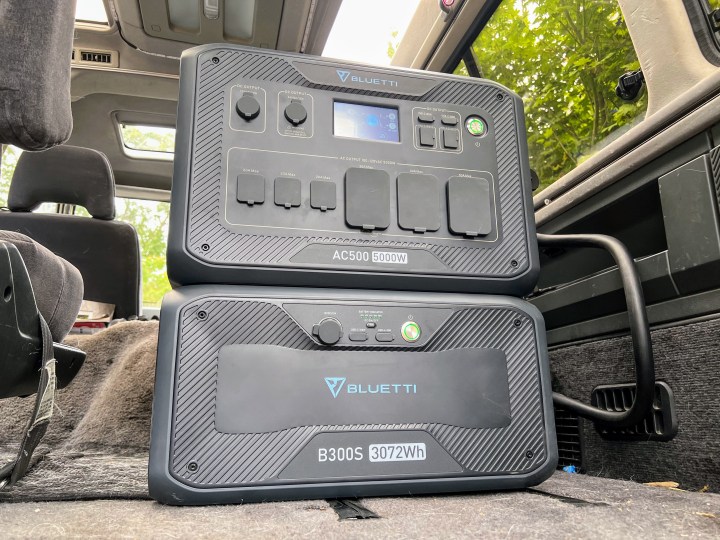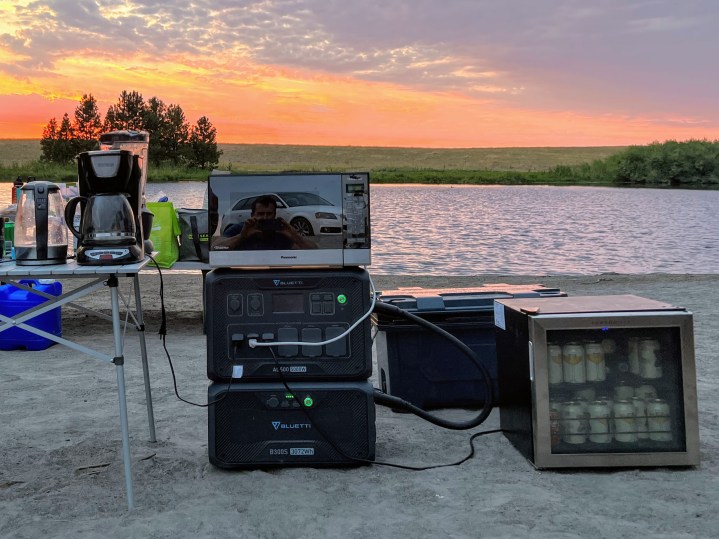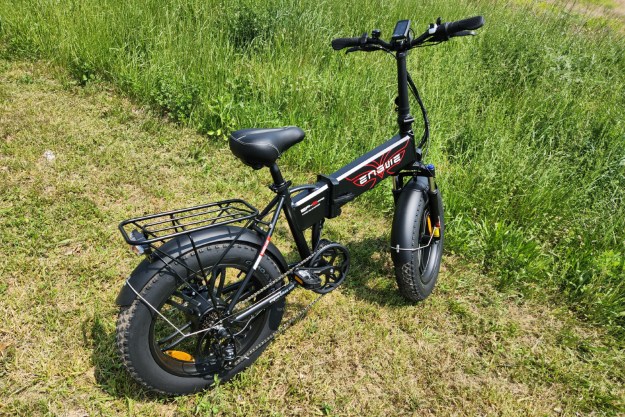You’re probably familiar with portable power stations that you can bring along on camping trips to charge your phone and power string lights. You’re probably also familiar with home backup systems like the Tesla PowerWall that can keep your entire house running when the electricity runs out. But you’re probably not familiar with the Bluetti AC500, which combines the power of the latter with the portability of the former. And it’s nuts.
Sized like a cooler and every bit as heavy, the AC500 can kick out a peak of 5,000 watts, which is more than double what the typical outlet in your home can deliver without popping a breaker. If that sounds like way, way more juice than you’d ever need in the woods, it is. Which is why I had to contrive an absolutely absurd scenario to test it.

Sure, it could power some lights, a speaker, a laptop. But can it power a fridge? A microwave? A boat motor? I had to find out. With a group camping trip on the horizon, I decided I’d use the AC500 to power only idiotic indulgences that would annoy and confound my friends. Could the AC500 handle them? Could my camp companions?
I heaped my van with an obnoxious menagerie of gadgets and drove to Eastern Oregon to test the capacity of modern battery chemistry, and the bonds of my friendships.
Stupid thing to power: Refrigerator
Power consumption: 88 watts
Group reaction: Eye-rolling acceptance
My first appliance pick was also my most pragmatic: A mini fridge. While companies like Dometic sell compact, efficient 12-volt fridges for overlanding, the AC500’s prodigious 120V output allowed me to pluck the mini fridge off my back patio and deposit it in my van without even removing the beer. It was almost convenient enough to justify the damage this may have caused my back.
That was really where the convenience ended, because the fridge in question was really too small for food, the door dragged on the sandy ground, and everyone seemed to prefer beer plucked from the icy depths of a cooler. Or maybe they just hated the cheap beer I stocked the fridge with. No matter, it still seemed like an eminently reasonable thing to bring in 97 degree temps. Alas, the fridge’s continuous need for power, combined with the idling drain of powering the Bluetti’s AC circuits, made this my thirstiest electrical indulgence.
Stupid thing to power: Blender
Power consumption: 1,501 watts
Group reaction: Genuine enthusiasm
With scorching weather at our campsite on the water, making blended cocktails seemed downright obligatory. Yes, you can buy “cordless blenders” on Amazon, but with a mere 300 watts on tap, these glorified soup stirrers would be lucky to lacerate a stalk of celery. The AC500’s surfeit of juice allowed me to pack a 1,200-watt NutriBullet that was sure to make short work of the ice and frozen pineapple I needed for piña coladas.

While my friends greeted the blender with furrowed brows, their skepticism melted with the first batch of piña coladas from this beast. Cups, I’ll concede, would’ve been a smarter accompaniment than the cocktail umbrellas I ordered last-minute on Amazon, which looked less festive nested in crusty coffee mugs. The blender’s real feat, though, was transforming 20 pounds of fresh watermelon into pitcher after pitcher of watermelon juice, which went down like, well, water.
Stupid thing to power: Boat motor
Power consumption: 120-plus watts
Group reaction: Unrestrained mocking
My sister-in-law once disparagingly referred to my inflatable SeaHawk II as a “boat made of air,” but I prefer to think of it as a minimalist yacht. Whatever you call it, mine is outfitted with an electric trolling motor that I’m accustomed to babying to stretch out a full day on the water. Not so with the AC500, which literally has eight times the capacity of the batteries I normally use. Full speed ahead!

Or so I imagined. After talking up the capacious B300S battery pack and lugging all 80 pounds of it to the boat, I confidently sped away from the beach, only to scramble in horror as the motor died five seconds later. Weathering a barrage of heckling from shore, I realized that the motor’s peak draw exceeded the 10-amp limit of the Bluetti’s DC output. There was nothing else to do but row to shore in shame and nurse my injured ego with the cheap beer nobody else wanted.
Stupid thing to power: Microwave
Power consumption: 1,849 watts
Group reaction: Disdain, redemption
Camping brings to mind fond memories of soup simmered over the blue flame of a Coleman stove and hot dogs lovingly roasted over a wood fire, which made the microwave by far one of my most obnoxious camping picks. “A microwave?” my friends cringed. I had simply gone too far. For 24 hours, the unwelcome box perched atop the fridge, neglected.
Until dinner on day two. Like the Rudolph of camping appliances, it was simply waiting for its time to shine. The humble Panasonic rose to the occasion of rapidly heating two enormous bowls of beans during the dinnertime crunch when stove space was at a premium. More importantly, in an environment when every crusty dinner dish has to be Brilloed by hand, it achieved this feat without dirtying any extra pots or pans. The cooks did rejoice.
Stupid thing to power: Coffee maker
Power consumption: 961 watts
Group reaction: Props given
Everybody loves a hot cup of coffee in the morning, but providing coffee for 12 people with a French press feels like digging a post hole with a soup spoon. Enter my household drip coffee maker, which would whip up 12 cups with the press of a button. But would anyone appreciate the humble machine?
Uh, yes. On-demand coffee for bleary-eyed campers is manna from heaven, and this machine pumped out carafe after carafe. My only regret was running out of coffee on day two, since I didn’t anticipate using it nearly as much. The warming function also eroded my battery life pretty aggressively, if I didn’t remember to kill it when the pot was empty.
Stupid thing to power: Water kettle
Power consumption 1,501 watts
Group reaction: Relief
Smitten as I am with the turbo boiling power of the isobutane-powered Jetboil, electric kettles are faster still. And I had room for one, so why not? I packed it inside the microwave to avoid shattering the delicate glass.
It turned out to be a lifesaver when my ground coffee ran out, since someone with more foresight had brought a large supply of instant coffee. Like the microwave, it was downright impressive to watch the kettle’s high drain and relatively long run time massacre my battery, and it was this very device that knocked my battery life to 0% on day three.
Can you have too much power?
Look, there might be a reason most power stations this big aren’t portable. Besides the weight and expense of hauling this much lithium into the woods, the gaggle of gadgets I dragged along took their toll. They gobbled up space in my van, made the campsite look like a QVC set, and required constant babysitting for battery life.

But you’ve gotta hand it to Bluetti: This thing does what nothing else will. Besides the boat motor, which exceeded the limit of the DC output on the battery alone (it goes up to 30A when paired with the inverter), nothing even came close to using all 5,000 watts the AC outlets can deliver. I mean, there is an outlet on this thing that can power a dryer.
If I have one key complaint, it’s the idle draw of the AC inverter, which nibbles away about 1 percent of battery life every hour or so, even with nothing drawing power. That’s a lot of wattage for nothing, and with all the brains in this thing, it should really have an option to automatically power that circuit down after enough disuse. The screen, barely legible in sunshine, is another knock, but the sleek mobile app is an easy fix for that.
So did it ruin my camping trip? No, and I think my friends would agree — if you caught them with a piña colada in hand. The novelty of 5,000 watts actually added a fun twist to camping, even if I’m still finding sand in my microwave.
Editors' Recommendations
- EcoFlow launches Delta 2 Max solar generator for home emergencies and outdoor adventures
- GoSun’s new portable power stations use the sun’s ray to charge devices
- This portable power station has 6 AC outlets and can charge a Tesla


